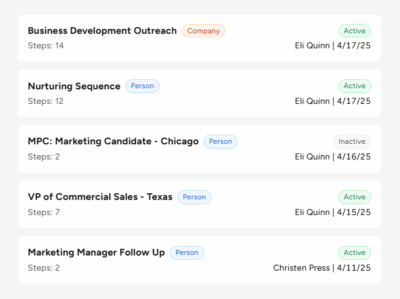If you’re a recruiter and you can successfully recruit passive talent, then you are going to be a successful recruiter, my friend.
The #1 reason for this is simple: your clients aren’t able to do it. They certainly can’t do it on a consistent basis, at the very least. Think about it. Why would your clients pay YOU to do something they can already do? They would not.
Recruiting passive candidates is a search consultant’s “sweet spot.” That’s one of the areas where they add the most value. It’s also why job board posting like Indeed and social media sites like LinkedIn will never replace recruiters.
If search consultants have a “trump card,” that card is their ability to successfully recruit passive candidates.
Before we get too far down the road, though, let’s define things. Specifically, let’s define exactly what passive candidates are.
What is a passive candidate?
Passive candidates are those candidates who are not actively looking for a new job. They are typically content and satisfied with their position. In addition, their current employer is keeping them busy and engaged. However, they would make a career move for a new opportunity if that opportunity is better than the one they have.
For the purposes of this blog post, a passive job seeker or “passive talent” is the same as a passive candidate. They’re not seeking a job, per se, but they are open to considering a new one.
An active job seeker, on the other hand, is actively looking for a new job. There are three main reasons why this is the case:
- They don’t have a job right now.
- They have a job right now, but they hate it.
- They have a job right now, but they see no future for them where they are.
The reality of the marketplace is that passive candidates are typically (although not always) more qualified for positions than their active counterparts. Their current employment situation illustrates this reality and this discrepancy:
- They’re employed. In other words, they’re considered valuable enough by at least one organization to be employed.
- They’re content and engaged at their current job, which means that their employer is treating them well. Organizations usually treat their most valuable employees in the best fashion. You’d think that companies treat all of their employees exactly the same . . . but we both know that is not the case.
- They’re busy, which means they don’t have any time to conduct a job search, anyway. The reason they’re so busy is because their employer considers them so valuable. And because they consider them so valuable, they bury them in work . . . and they’re paying them quite well for it.
So . . . you have clients on the one hand, wanting to see the most highly qualified candidates possible for their open positions. And you have passive candidates on the other side, who aren’t really looking for a new job, but would consider it if the job was better than what they have now.
The conclusion? Successfully recruiting passive candidates will help you make a lot of placements!
Passive candidate recruiting can be broken down into segments or steps. Because after all, recruiting is a process. Actually, the recruitment process for passive talent is made up of smaller processes. Those three steps are as follows:
- Sourcing passive candidates
- Attracting passive candidates
- Recruiting passive candidates
How to source passive candidates
Passive candidate sourcing is another way of saying “identifying passive candidates.” After all, how can you target somebody if you don’t even know WHO that somebody is? And just for the record, sourcing passive candidates is different than recruiting passive candidates. Sourcing vs. recruiting is a whole new animal. (And it’s even different than attracting them, as you’ll see.)
Why is that? The logic is simple. You can identify somebody and not recruit them. You just know who they are. However, knowing who they are is the first step in the process of recruiting them. Below are six main passive candidate sourcing techniques that search consultants can leverage:
#1—Their own recruiting database
Regardless of which recruiting software or applicant tracking system you use, the possibility exists that the perfect passive candidate could be residing in there. If you’ve been a recruiter for any appreciable length of time, then you probably have a ton of candidates in your recruiting database. There could be “gold in them thar hills!”
#2—Referrals
Let’s say you’ve identified some potential passive candidates in your database. So you begin cold calling candidates. Lo and behold, not all of them are interested in your client’s opportunity. So before you hang up the phone, you ask, “Do you know anybody who might be qualified and interested in an opportunity like this?” Top passive candidates likely know other top passive candidates. They travel in packs.
#3—Social media
Yes, you can source candidates on social media sites other than LinkedIn. In fact, Facebook recruiting is an extremely valuable way to source passive candidates. You just have to know how to use these candidate sourcing techniques effectively. You can also source candidates to a lesser degree on Twitter. However, as we all know, LinkedIn is still the most popular social media site for sourcing passive candidates.
Below are links to two recruiter training videos by Shally Steckerl of The Sourcing Institute. These videos can help you to source passive candidates through social media:
#4—Google
You can source passive candidates through Google? Of course! Google does everything! Didn’t you now that? Like finding quality candidates on Facebook, a Google resume search can be an effective strategy if you know how to do it. When it comes to identifying passive candidates, you can never have too many arrows in your quill.
#5—Specialized sourcing tools and techniques
In addition to social media and Google, there are other Internet-based sourcing tools and recruitment management systems that are available. However, some recruiters do not know that these specialized tools and techniques exist.
That’s why Top Echelon has called upon some of the best sourcers and trainers in the recruiting industry to conduct free recruiting webinars and record videos. In addition to Steckerl, those trainers include Glenn Gutmacher of Diversity Talent Sourcing and Mike Walmsley.
Below are the free webinar videos available by Gutmacher. (Click on the links to watch the videos):
Below is the free webinar video available by Walmsley. (Click on the link to watch the video.)
Each of these webinar videos offers strategies and techniques for sourcing passive candidates. After watching them, you might have another arrow or two in your quiver.
#6—A recruiter network
In a recruiting network that specializes in split placements, recruiters share job orders and candidates. So if you don’t have enough candidates in your own database, you can search the candidates that other recruiters have shared through a split fee recruiting network. With more candidates comes the increased chance that you’ll find top passive candidates.
How to attract passive candidates
Now that you’re past the “identify stage” of passive recruiting, it’s time to attract these candidates. Attracting passive candidates is the next step in the process of recruiting them. As we’ve discussed, these candidates are open to exploring a new opportunity, but only if that opportunity is better than the one they have now. In other words, you’re going to have to get their attention. In yet more other words, you’re going to have to attract their attention.
Let’s start with the most obvious way: cold calling recruitment. Calling passive candidates involves a different process than calling other candidates. You need more than just a recruitment script to attract a passive candidate. You need an approach and a strategy that includes a bit of psychology, a calculated process, and an awareness of how the candidate is viewing the call.
For more detailed information about cold calling passive candidates, check out our blog post, “How to Talk to a Candidate as a Recruiter.”
You can also attract passive candidates with your agency’s website. As a general rule, passive candidates do not look at the job boards. That’s because they’re not actively looking for a job. However, you can still get them to apply for a job online. How’s that, you ask?
- Step one: Make sure your firm has a website.
- Step two: Make sure the site has job board integration, whereby you can post your jobs on the site.
- Step three: Use the job board’s functionality to advertise those jobs through LinkedIn, Facebook, and Twitter.
Are passive candidates looking for new jobs on Indeed and Monster? Probably not. But might they be following you on social media? They might. And if they are, might they see those jobs and be compelled to apply for them. After all, they didn’t actively seek them out. They passively saw them in their social media feed. BOOM!
We invite you to view the recruiter training video “Upgrade Your Job Postings to Stand Out in Social Media” by Steckerl.
There is a “secret sauce” involved in any strategy designed to attract passive candidates. That “secret sauce” is building relationships. When you build relationships with top candidates by continuing to stay in contact with them, you find out a few things:
- How they want to grow their career
- What’s most important to them in a new employment opportunity
- Their professional goals
- Under exactly what circumstances they would make a move
When you know this information, it makes attracting them so much easier. That’s because you’re not hoping to attract them with something they might want. Instead, you know you will attract them because you have something they definitely will want.
So build those relationships and then pick up the phone when the time is right!
How to recruit passive candidates
Okay, you’ve identified (sourced) the passive candidates. You’ve successfully attracted them and have their attention. Now it’s time for the full-court press. It’s time to recruit them. There are three things to keep in mind during this stage:
- These candidates are only going to make a move if that move is better than what they have. So you must emphasize all the ways that the new opportunity is better than what they have. They can not think that it’s a lateral move in any way.
- You must recruit them on a number of different things. It’s not just the job itself. That’s only one part of a larger equation.
- You should keep recruiting all the way through the process, even after they’ve accepted the offer! You know the phrase, “Never stop selling”? Well, never stop recruiting! Ever!
Okay, let’s examine the second point above more closely. Recruiting passive candidates requires a comprehensive approach. You must convince them that this is the best move for their career. With that in mind, below are the different ways in which to convince them:
#1—Recruit on the opportunity.
Of course you’re going to do this. But once again, the opportunity should absolutely be better than what the candidate has. Sure, that includes money and compensation, but that’s just a part of it. Top candidates know they can get the money. They want other things, like opportunities for professional development and the chance to add more skills and experience. They want to keep climbing the ladder in every sense of the word. (Except, you know, climbing an actual ladder.)
#2—Recruit on the organization.
This is a huge consideration for top talent. They want to work for the best organizations. They want to work for companies that have big goals and a huge impact on the industry. They also want to work for organizations that have the same core values as they do. That means you’re going to have to know what the candidate’s core values are. Dig deep. And then dig deeper. The perfect match lies in the details.
#3—Recruit on the company culture.
This is also a big consideration for top talent these days, especially the younger generation. They want to work in an environment in which they feel comfortable. This is a generation that’s seen the rise of mega-companies such as Google, Amazon, Apple, and Zappos. They’ve seen the allure of the company culture that those organizations have. Not that your clients have company cultures that are comparable. However, for top candidates, culture matters more than it ever has.
#4—Recruit on what the move will mean for their career.
Top passive candidates view everything in terms of their career, NOT just their current job. They have a vision for the future that holds their attention more than the present does. You need to tap into that vision and tie it to the opportunity. Show the candidate how, in no uncertain terms, the position will help them to achieve their long-term goals. That’s how you close candidates when it’s a candidates’ market, friends and neighbors.
The art of recruiting passive candidates: the shortcut that isn’t one
Passive candidate recruiting could be considered an art form. It’s difficult, although not impossible, for new recruiters to quickly master its intricacies. But as with most endeavors, you become better over time.
The longer you’re in the recruiting industry, the better you will become at recruiting passive candidates. That’s because you’ll talk with more of them, you’ll find out how they think, and you’ll adjust your strategy accordingly. Not only that, but as mentioned above, you’ll have the opportunity to build relationships with them.
So if you’re looking for a shortcut for effectively recruiting passive candidates . . . there isn’t one. However, there IS a way to make recruiting them easier in the long run.
- Build up your database with high-quality candidates.
- Build relationships with as many of them as possible.
- Keep track of what’s important to them and why they would make a move.
- Contact them when you have an opportunity that would cause them to make a move.
Does this approach increase your success rate? Absolutely! Is it a shortcut? Absolutely not! It takes years to accomplish something like this because it takes years to build these kinds of relationships.
But ultimately, it’s worth it. After all, you’re planning on being a recruiter for years to come, right? Of course you are! Long-term success requires a long-term investment.
Especially when it comes to recruiting passive candidates.











